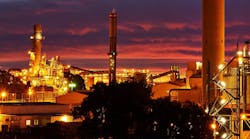Sanctions on Russian competitors are nice. Strengthening demand from most customer segments and geographic markets is far nicer.
That was the message Alcoa Corp. President and CEO Bill Oplinger delivered to analysts and investors April 17 after the Pittsburgh-based company reported first-quarter results. The optimism builds on Oplinger’s cautiously upbeat commentary in January, when he said 2024 was “starting to look like a positive turning point.”
“In just about every industry and every region that we serve—with the exception of European building and construction—if it's packaging, automotive, transportation, electrical transmission, we’re seeing growth,” Oplinger said on a conference call. “We’re really feeling as if we’re in a spot where we’re getting some tailwinds from the marketplace.”
Oplinger’s upbeat comments add another positive data point to recent manufacturing indicators that showed industrial production picking up and upswings in both the current- and future-activity readings in the Manufacturing Business Outlook Survey from the Federal Reserve Bank of Philadelphia. Oplinger specifically called out the automotive and electrical sectors as showing strong demand and added that the packaging sector is showing “signs of recovery.”
Alcoa produced 542,000 metric tons of aluminum in the first three months of this year, which was up a tick from Q4 but a nearly 5% increase from early 2023. Similarly, the company shipped 634,000 tons versus 600,000 a year earlier. Alumina production, however, slipped 3% to 2.67 million tons, in large part because the company began curtailing refining operations at a 60-year-old Western Australia plant in January as a response to market conditions as well as its operating costs and age.
The upswing in Alcoa’s business hasn’t yet filtered down to the company’s bottom line because it’s relatively early days and because of other measures Oplinger and his team have been taking. (In the first quarter, they booked $202 million in restructuring and other charges, most of it related to the Australian refinery.) But the company’s adjusted EBITDA rose to $132 million in the first quarter from $89 million in the last three months of 2023 thanks largely to lower energy and materials costs.
A more recent development, Oplinger said, is firmer pricing for Alcoa’s products; the London Metal Exchange price per ounce of aluminum has climbed to nearly $2,600 from below $2,200 at the beginning of March. The U.S. Treasury’s April 12 announcement of new sanctions on imports of and trading in Russian metals is helping on that front but Oplinger made it clear his team sees strengthening demand (coupled with relatively few supply additions in the pipeline) as a contributor as well.
One other item of note from Alcoa’s Q1 report: The company has formally begun looking for a buyer for its San Ciprián smelter and refinery complex in Spain, which Oplinger has repeatedly said is not viable because of its high energy costs. Per an agreement with local workers and government leaders, Alcoa restarted about 6% of the plant’s pots in Q1 but Oplinger said the plant will run out of cash in the second half of this year.
“At that point, Alcoa Corporation will not provide further funds and hard decisions will need to be made,” he added.
Shares of Alcoa (Ticker: AA) fell slightly April 18 to $35.47, a day when the broader market also was essentially flat. Over the past six months, they have climbed more than 30%, a move that has grown the company’s market capitalization to nearly $6.4 billion.



